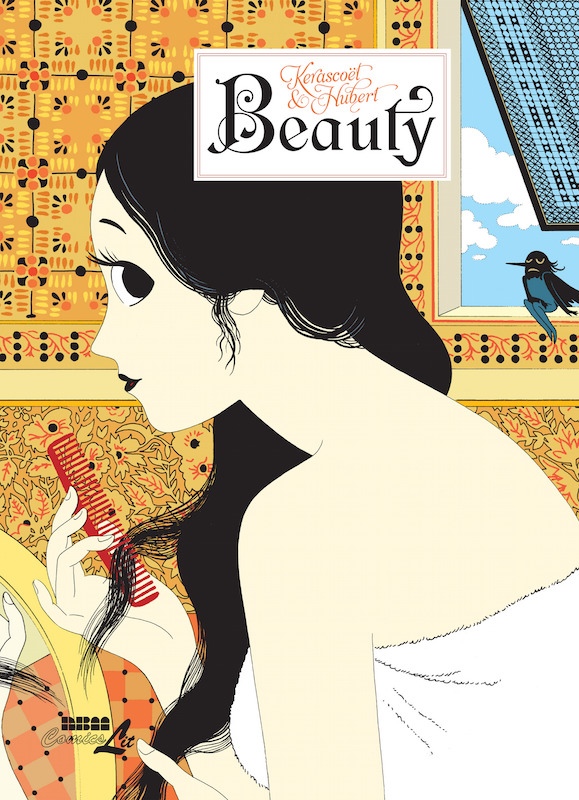Story: Hubert Boulard
Art: Kerascoët (Marie Pommepuy and Sébastien Cosset)
Letters: Ortho
Translation: Joe Johnson
At first glance, Beauty looks like a classic “Be careful what you wish for” story. In these type of stories, the protagonist comes to regret a wish that has come true because its fulfillment exposes terrible unforeseen consequences. Or something essential has to given up in the bargain. Or the manner in which the wish has come true was less than ideal. This usually leads to either a tragic ending, or more innocuously a successful reversal of the wish. In the latter, the hero comes away chastened by the experience. It's ultimately a genre with a conservative message. The graphic novel Seconds was a modern use of this trope. In comparison, Beauty contains more traditional elements. It starts out as a mashup of the myth of King Midas with Cinderella. But writer Hubert and husband and wife art team of Kerascoët subvert the morality of the tale and turn the wish into a catalyst for personal growth and eventually greater actualization. Though not before the experience puts our heroine through the wringer.
The comic’s setting is the pseudo-medieval Europe of most fairy tales and fantasy novels. Kerascoët brings this world to life with the characteristic use of Ligne claire, bold, flat colors, and nonlinear perspective images, neatly composed on each page as a four panel high-tiered grid. The effect is a dense visual narrative which is far more iconic than realistic. This enhances the impression of an exotic world populated by mysterious magical forces. The character designs conveniently fit into easily-recognized archetypes: the poor peasant, the handsome knight, noble king, beautiful queen, or violent warlord.
This artistic choice serves the comic’s key narrative device. The heroine is a poor, put-upon girl named Coddie who is on the verge of womanhood. One day, she inadvertently frees the fairy Mab from a magical prison and is granted one wish as a reward. Coddie wants to be beautiful, but Mab cannot change her. Instead, she imparts on Coddie a glamour which creates the illusion of beauty to whoever sets eyes on her. As such, the story is constantly shifting between Coddie’s true form and her idealized appearance. Coddie is aware of her physical imperfections every time she sees her own reflection, but this also highlights her pettiness, superficiality, and shortsightedness. To everyone else, her ethereal visage simply disarms any valid objections to her questionable behavior. Kerascoët’s art easily conveys how when even in the company of other attractive people, Coddie’s illusory charm makes her seem otherworldly in comparison.
The disadvantages of being an incarnation of the feminine ideal becomes quickly apparent when shortly after her encounter with Mab, Coddie is spotted by several of her male neighbors and they later try to gang rape her. The women react to this incident by driving Coddie out of the village. It doesn’t take long for Coddie to become a Helen of Troy object of desire as people either woo, worship, and fight for her approval. Or alternately attempt to manipulate, capture, imprison, possess, or consume her. As her legend grows, so does the chaos accompanying her until it threatens to engulf the entire kingdom.
But Coddie isn’t an impassive figure. The granting of her wish connotes an obvious sexual awakening. So she behaves like an adolescent who suddenly becomes aware of the power she holds over the opposite sex. Coddie seduces a succession of powerful men as she moves up the social ladder. But unsurprisingly, she exhibits poor judgement and self-control. And her naive understanding of love and adult relationships causes greater misery for her lovers and the people around her.
Hubert and Kerascoët infuse the story with a number of modern touches. They don’t ignore the harsh social inequalities between peasant and nobility, not to mention the patriarchal nature of the feudal system of government. As a commoner, Coddie is easily tempted by the lavish lifestyle of the aristocracy. But unlike the typical fairy tale heroine, she doesn’t live happily ever after once she marries into royalty. Two other noble women in the story are forced to treat Coddie as a rival or a threat because of the inordinate amount of influence she exerts over the men. At some point, even the peasants (or at least the peasant women) turn on her after her attempts to alleviate their suffering backfires. There’s only so much one can accomplish when being viewed more as an object than a person. While not as blunt as Game of Thrones, the book's depiction of violence and misery can be fairly graphic at times.
Indeed, everything has gone wrong for Coddie past the midway point. But where most traditional storytellers would have been content to leave off with a cautionary tale about accepting one’s limitations, this is when Coddie begins to apply the harsh lessons of her life and gradually fights back. By the end she attempts to turn the tables on her tormentors and strikes a crucial balance. The results don’t necessarily violate the rules of the comic’s fantastic milieu, but the story's concluding point is persuasively up to date.




